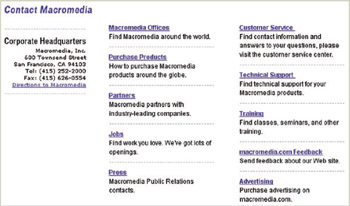Blooper 3: Unhelpful Descriptions
| < Day Day Up > |
Blooper 3: Unhelpful Descriptions
Websites often display a choice of products or services, each one with a name , a brief description, and (for products) perhaps a picture. Two things to keep in mind:
-
The information about the items should allow people to determine whether any are what they want.
-
In case multiple items seem relevant, the information should help choose between them.
These guidelines apply not only to descriptions of products and services, but also to descriptions of sections of the site itself.
At many websites, item names and descriptions do not help site visitors with either of these two decisions. Often, it seems as if they were written at different times, by different people, with no coordination, no consideration of how the items might best be contrasted, and no thought to how item descriptions will be interpreted in the context of the array in which they appear.
A good example comes from the website of Pitsco-LEGO Dacta, a maker of construction toys. The company has two catalogs customers can order. Unfortunately, the names and descriptions of two product catalogs appear to have been written without regard for each other (Figure 1.12). Both the catalog names and the descriptions are just noise words carrying no information in this context: "new, bigger, better," " brand-new , full- color ." There is nothing here to help site visitors choose between the two catalogs. I'll bet many people simply order both and decide when they get them which one is relevant to them.

Figure 1.12: www.Pitsco-LEGOdacta.com (Feb. 2002)-The names and descriptions of two product catalogs were apparently written in isolation and don't help site visitors choose between them.
For an example of a poorly written set of product descriptions, let's look at a software download page from Netscape.com. The descriptions on the page aren't just unhelpful for distinguishing the items, they are actually misleading (Figure 1.13).

Figure 1.13: www.Netscape.com (June 2002)-The names and descriptions of three software download packages are not only unhelpful for distinguishing between them but also misleading.
Assume that you want Netscape Communicator-the whole works: Web browser, email reader, instant messager, calendar, and other tools. Which item would you click? The header "Netscape Communicator" naturally grabs your attention; it exactly matches what you want. However, a closer look reveals that this item is for Communicator 4.79, which at this point is almost two major releases old. What you actually want is the first item. Why is it labeled "Netscape 6" instead of "Netscape Communicator 6?" Because that's what the person who added it to the page called it.
Now assume you don't want the whole Communicator package. You just want the latest browser, in this case Netscape Navigator 6. Which item would you click? The third one, perhaps? Sorry, that's an old link for downloading Netscape Navigator 4.76. To get the latest browser, you must choose the first item and perform a custom, rather than a normal, installation.
It seems that Netscape never updates a link name or description once it goes up, even if that name or description no longer is current. In fact, the list of items is not really a catalog of choices at all, but an archive of past downloads. Interesting for Netscape's developers, perhaps, but useless to Netscape customers.
Avoiding the Blooper
When a website or Web-based application displays a set of items, information about the items must help users answer two questions:
-
Do any of these items match what I want?
-
Which of these matching items best suits my purpose?
To do that, the item names and descriptions should not consist of marketing noise words, such as new, bigger, awesome , and fully functioned! They should consist of honest descriptions of what the item does and does not do, perhaps with reference to other items that have something a given item lacks.
Also, item descriptions cannot each be written in isolation, each by its own product manager. You can't list 10 products all claiming "Does everything you need!" You also don't want items to inadvertently detract from other items. Item descriptions must be written together, with consideration for how they will be interpreted in context and how they contrast with each other.
The electronic products page of SharperImage.com provide an example of excellent descriptions of stereo systems (Figure 1.14). Visitors to this page will have no trouble understanding how products differ .

Figure 1.14: www.SharperImage.com (Sept. 2002)-Products in a family are easy to distinguish from their pictures and descriptions.
Similarly, the home page of Macromedia, a software company known for its Director and Flash products, provides good descriptions of the various sections of the site. The labels and brief descriptions of the sections of the website allow a clear choice between them (Figure 1.15).

Figure 1.15: www.Macromedia.com (June 2002)-Site sections are well described and easy to distinguish.
When new items are added, old items, if they are retained, should be revisited and possibly revised to ensure that they contrast properly. Alternatively, old items can be deleted or removed to an Archive category.
Finally, a website's category names should be tested on representative users, to see whether they actually mean to users what the site designers intended them to mean. If users misinterpret the category names, the users aren't wrong, the designers are, and the names need to be changed.
| < Day Day Up > |
EAN: 2147483647
Pages: 128
- Chapter VIII Personalization Systems and Their Deployment as Web Site Interface Design Decisions
- Chapter X Converting Browsers to Buyers: Key Considerations in Designing Business-to-Consumer Web Sites
- Chapter XII Web Design and E-Commerce
- Chapter XV Customer Trust in Online Commerce
- Chapter XVI Turning Web Surfers into Loyal Customers: Cognitive Lock-In Through Interface Design and Web Site Usability